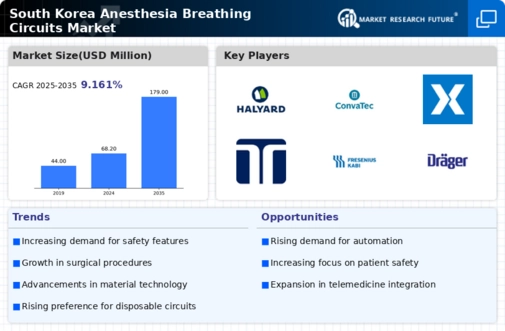Rising Surgical Procedures
The increasing number of surgical procedures in South Korea is a primary driver for the anesthesia breathing-circuits market. As healthcare facilities expand and improve their surgical capabilities, the demand for effective anesthesia management rises. In 2025, it is estimated that the number of surgeries performed will reach approximately 1.5 million annually, leading to a corresponding increase in the need for anesthesia equipment. This trend is further supported by advancements in minimally invasive surgical techniques, which often require precise anesthesia delivery systems. Consequently, the anesthesia breathing-circuits market is likely to experience substantial growth as hospitals and surgical centers invest in high-quality breathing circuits to ensure patient safety and optimal outcomes.
Growing Geriatric Population
The aging population in South Korea is a significant driver of the anesthesia breathing-circuits market. As the geriatric demographic expands, the prevalence of age-related health issues requiring surgical intervention increases. By 2025, it is projected that over 20% of the population will be aged 65 and older, necessitating more frequent surgical procedures. This demographic shift compels healthcare providers to invest in reliable anesthesia solutions, including advanced breathing circuits tailored for older patients. The anesthesia breathing-circuits market is likely to benefit from this trend, as manufacturers develop products that cater specifically to the needs of the elderly, ensuring safety and efficacy during anesthesia administration.
Increased Focus on Patient Safety
Patient safety remains a paramount concern in healthcare, significantly influencing the anesthesia breathing-circuits market. In South Korea, healthcare providers are increasingly adopting stringent safety protocols to minimize risks associated with anesthesia administration. This heightened focus on safety has led to the integration of advanced monitoring systems and high-quality breathing circuits designed to reduce complications during surgery. As a result, the market is projected to grow at a CAGR of around 6% over the next few years. The emphasis on patient safety not only drives demand for innovative products but also encourages manufacturers to enhance the reliability and efficiency of their anesthesia breathing-circuits.
Expansion of Healthcare Infrastructure
The expansion of healthcare infrastructure in South Korea is a vital driver for the anesthesia breathing-circuits market. With ongoing investments in hospitals and surgical centers, the demand for anesthesia equipment is expected to rise. The government has been actively promoting healthcare development, leading to the establishment of new medical facilities and the upgrading of existing ones. This growth in infrastructure is likely to create a favorable environment for the adoption of advanced anesthesia technologies, including high-quality breathing circuits. As healthcare providers strive to meet the increasing patient load, the anesthesia breathing-circuits market is anticipated to flourish, driven by the need for efficient and reliable anesthesia delivery systems.
Technological Innovations in Anesthesia Delivery
Technological innovations play a crucial role in shaping the anesthesia breathing-circuits market. The introduction of smart breathing circuits equipped with sensors and real-time monitoring capabilities is transforming anesthesia delivery. These advancements allow for better control of gas flow and improved patient outcomes. In South Korea, the market for such innovative products is expected to expand as healthcare facilities seek to enhance their operational efficiency. The integration of technology into anesthesia practices is likely to lead to a more streamlined workflow, ultimately benefiting both healthcare providers and patients. As a result, the anesthesia breathing-circuits market is poised for growth driven by these technological advancements.





















Leave a Comment